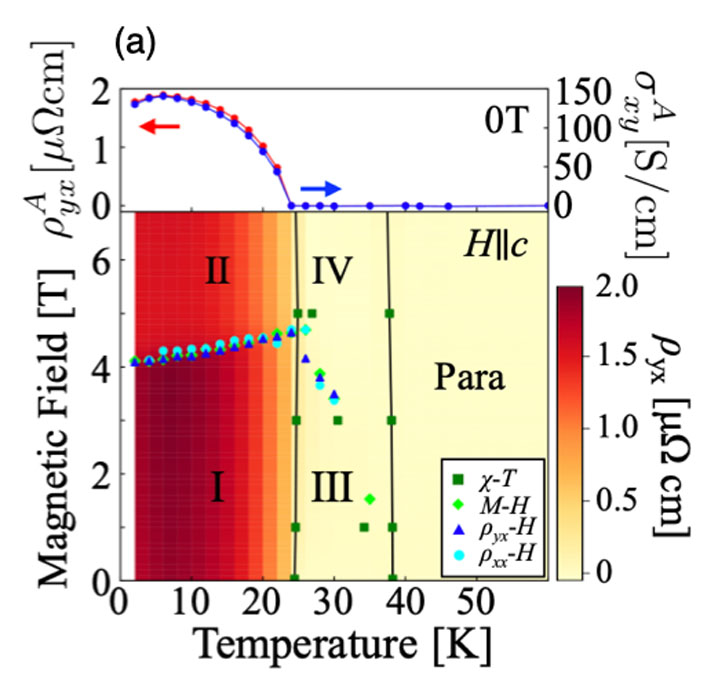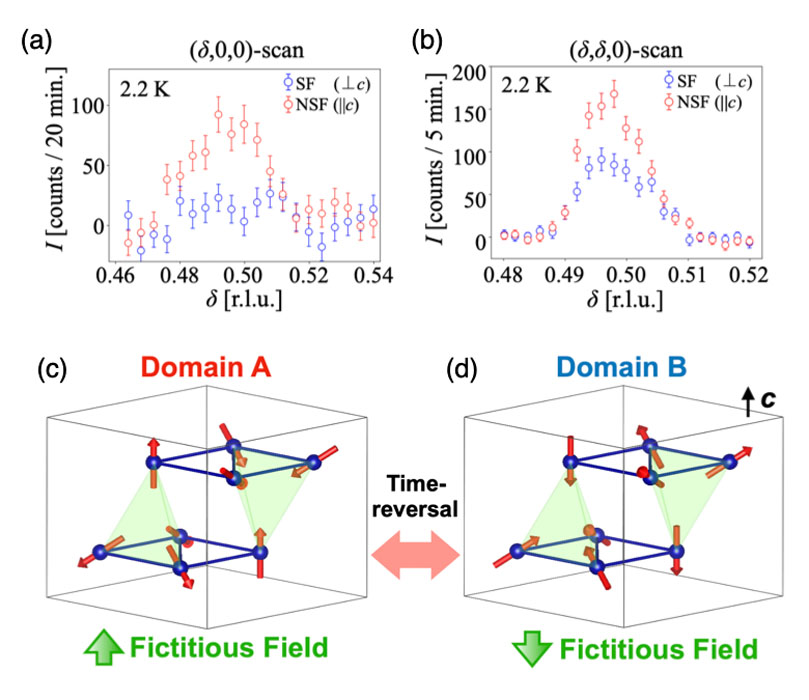Topological Hall Effect Induced by Non-Coplanar Magnetic Structure in van der Waals Magnets
PI of Joint-use project: S. Seki
Host lab: Neutron Science Laboratory
Host lab: Neutron Science Laboratory
Antiferromagnets with broken time-reversal symmetry (TRS) have been attracting remarkable attention since the discovery of the large Hall effect in the kagome antiferromagnet Mn3Sn [1], which exhibits a coplanar 120-degree spin order on the kagome lattice. From the viewpoint of symmetry, this magnetic structure is compatible with the in-plane ferromagnetic order, and thus accounts for the large Hall effect despite the extremely small net magnetization. These properties would be applicable for novel information storage/processing devices with small stray fields and faster spin dynamics. Thus far, the number of this class of materials has been limited, and further exploration of TRS-broken antiferromagnets is highly demanded.
In the present study, we focus on the van der Waals materials composed of triangular lattice layers of magnetic ions, CoTa3S6 (CTS) and CoNb3S6 (CNS), which have been recently reported to show large Hall effect in the antiferromagnetic ordered phases [2,3]. However, the magnetic structures of these compounds were not investigated in detail. We thus performed polarized neutron scattering experiments on these compounds at the POlarized Neutron Triple-Axis spectrometer (PONTA) installed in the 5G beamline of the Japan Research Rector 3 (JRR-3), in order to elucidate the magnetic structure relevant to the large Hall effect [4].
Single crystals of CTS and CNS were synthesized by the chemical vapor transport method. As for CTS, we observed the large spontaneous Hall effect in zero magnetic field, as shown in Fig. 1(a), as if the conduction electrons were subject to a magnetic field along the c axis of the crystal. We mounted a single crystal of CTS on a standard 4He closed-cycle refrigerator with the (H,K,0) scattering plane, and measured magnetic reflections with polarized neutrons. Figures 2(a) and 2(b) show the scattering profiles of the magnetic Bragg peaks at (1/2,0,0) and (1/2,1/2,0) at the lowest temperature. The incident neutrons were polarized along the c axis of the crystal, that was perpendicular to the scattering plane. By using a spin flipper and an analyzer of a magnetic Heusler-alloy crystal, we measured the intensities of the scattered neutrons in the non-spin-flip (NSF) and spin-flip (SF) channels, which correspond to the Fourier-transformed magnetic moments parallel to the c axis and that perpendicular to both the c axis and the scattering vector, respectively. We found that the reflection at (1/2, 1/2, 0) contains both the NSF and SF signals, suggesting that the system has non-coplanar magnetic structure. By representation analysis, we obtained possible bases of the magnetic structure, and found that the observed SF and NSF intensities can be reproduced by the all-in-all-out type magnetic structure constructed by a linear combination of the possible bases, as shown in Figs. 2(c) and 2(d). This magnetic structure breaks the time-reversal symmetry, and thus has the two domains, each of which is interconverted to the other by the time-reversal operation. Therefore, these two domains are compatible with the ferromagnetic state with up and down magnetic moments, respectively, and exhibit the large Hall effect with opposite signs. We also investigated the magnetic structure of CNS in the same manner, and found that this system also has the all-in-all-out type non-coplanar magnetic structure. We also performed time-of-flight neutron diffraction measurements on CTS in Material and Life-science experimental Facility (MLF) of J-PARC, and also carried out first-principles calculations based on the density functional theory. Both confirmed the all-in-all-out magnetic structure. We note here that this magnetic structure has finite scalar spin chirality, Si・(Sj×Sk), which can induce a fictitious magnetic field acting only on the conduction electrons by adding qua
References
- [1] S. Nakatsuji et al., Nature 527, 215 (2015).
- [2] N. J. Ghimire et al., Nature Commun. 9, 3280 (2018).
- [3] P. Park et al., npg Quantum Materials 7, 42 (2022).
- [4] H. Takagi et al., Nature Physics (advanced online publication) (2023).


